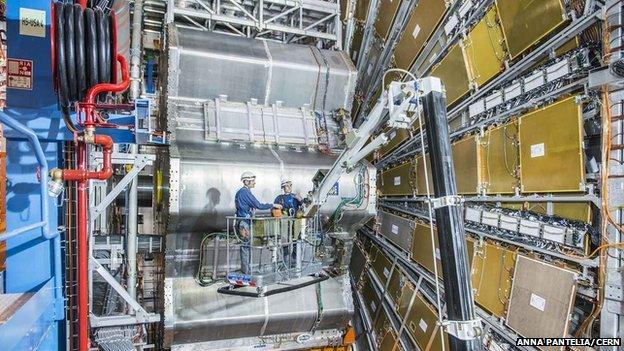How close are we to finding dark matter?
- Published

LUX in South Dakota is the most sensitive dark matter detection experiment yet
Dark matter makes up about a quarter of the cosmos, but we still don't know what it is. As part of a two-part series called Light & Dark on BBC Four, physicist Jim Al-Khalili pondered how close we are to understanding the mysterious "dark stuff".
Given all the progress we've made in modern physics over the past century, you may be forgiven for thinking that physicists are approaching a complete understanding of what makes up everything in our Universe.
For example, all the publicity surrounding the discovery of the Higgs boson last year seemed to be suggesting that this was one of the final pieces of the jigsaw - that all the fundamental building blocks of reality were now known.
So it might come as something of a shock to many people to hear that we still don't know what 95% of the Universe is made of.
It's all rather embarrassing. Everything we see: our planet and everything on it, the moon, the other planets and their moons, the Sun, all the stars in the sky that make up our Milky Way galaxy, all the other billions of galaxies beyond with their stars and clouds of interstellar gas, as well as all the dead stars and black holes that we can no longer see; it all amounts to less than 5% of the Universe.
And we don't even know if space goes on for ever, what shape the Universe is, what caused the Big Bang that created it, even whether it is just one of many embedded multiverses.
About a quarter of all the stuff in our Universe is thought to be made up of dark matter. We know this because galaxies appear to weigh a lot more than the sum of all the normal matter they contain that we know about.
Many astronomical observations, including the patterns made by galaxies in the night sky, the motions of stars within a galaxy and the images of distant galaxies distorted by the intervening matter, all point to the unmistakable gravitational effect of some sort of elusive invisible - and therefore.. erm... dark matter.
For example, the stars in galaxies revolve around like undissolved coffee granules on the surface of your mug of coffee just after you've stopped stirring it. The faster the stars are moving, then the harder they must be pulled towards the centre to keep them from flying away.
If the only matter in the galaxy was the stuff you could see then the outer stars should be revolving much more slowly than they actually are. In fact they are moving round so fast that without some extra gravitational force to hold on to them, they'd be flying off into the depths of space.
The only way to explain the way these stars are observed to behave is if there is additional gravitational attraction due to some kind of invisible form of matter, which surrounds the stars. And to have the effect it does, it would have to contain many times more mass than all the visible forms of matter put together.
The problem with dark matter is that, whatever it is made of, it seems to interact very weakly with normal matter. This makes it very hard to catch - like trying to catch a shadow. In fact, it streams right through the Earth as easily as sunlight passes through a glass window.
There are three different ways we can try to find out what dark matter is made of. We can look out into space and see the results of collisions of dark matter particles by trying to detect the normal matter particles created in the debris of these collisions; or we can try to catch dark matter particles directly as they stream through the Earth; or we make them ourselves in particle accelerators like the Large Hadron Collider at Cern.
It is the second of these methods though that is the most promising as far as current experiments go.

Dark matter can be mapped by studying its gravitational effects on the matter we can see
Most scientists believe that dark matter takes the form of particles called Weakly Interacting Massive Particles, or WIMPs, and that millions of these are streaming through us every second without a trace. In the last decade, there have been a number of announcements by different research groups around the world claiming to have seen hints of these elusive particles. One group has even claimed to have detected a dark matter signal definitively.
Several of these experiments are taking place at the Gran Sasso National Laboratory in central Italy, the world's largest underground laboratory, which lies beneath almost a kilometre-and-a-half of solid rock and can only be reached through a tunnel cut deep into the Italian Apennines.
The reason for this is because our planet is also constantly being bombarded by cosmic rays, which collide with the upper atmosphere creating a cascade of particles that shower down onto the surface of the Earth.
The rock above the laboratory effectively forms a 1,400m-thick roof that absorbs most of these particles, shielding and protecting the equipment below. But crucially for the researchers, dark matter itself passes straight through the rock, and, the hope is, into their detectors.
However, much recent excitement in the dark matter community has been surrounding the latest results from another underground laboratory. The LUX (Large Underground Xenon) detector is situated down a deep gold mine in South Dakota.

The Large Hadron Collider will be used to probe the dark matter mystery when it re-starts in 2015
Its first three-month run took place earlier this year and while it did not detect any dark matter particles, it has shown itself to be the most powerful and sensitive detector of its kind so far.
It has already ruled out a number of candidate signals seen in other experiments - and knowing what dark matter isn't is almost as important as knowing what it is. Next year it is to begin its work in earnest.
Scheduled to start in 2014, this will be a continuous 300-day run that, it is hoped, will finally directly detect dark matter particles. And if it doesn't, well physicists are already designing a new bigger and more sensitive detector: the LZ experiment, which they believe should definitively detect WIMPs - if they're out there.
Of course, if physicists continue to come up empty-handed in their search, then it just may be that we've got it wrong about dark matter altogether. If it turns out not to be made up of WIMPs we will have to go back to our blackboards in the search for an alternative theory and explanation for what we are seeing through our telescopes.
And what happens when we solve the dark matter mystery? Well, there's still the two thirds of the Universe that is even more mysterious - the stuff called dark energy. And we have hardly even begun to figure out how to go looking for that.
Professor Jim Al-Khalili's new two part series Light & Dark begins on BBC4, Monday 18th November at 9pm.
- Published30 October 2013
- Published9 October 2013
- Published9 January 2012
- Published18 January 2013
- Published6 February 2013